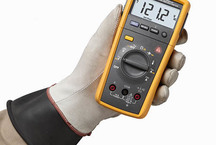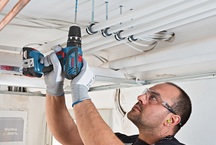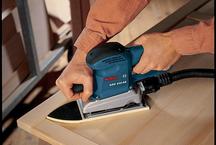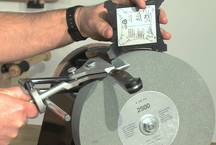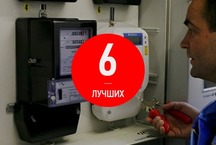Top 10 wiring detectors

It is not necessary to start a full-scale repair at home to stumble upon a “non-sudden” electric cable while drilling the wall - you may need to drill a hole under a single anchor, and a tricky piece of live wiring is already waiting in the wings. If your work is directly related to this, then the need for a hidden wiring detector will be obvious. Fortunately, modern devices are much more accurate and functional than the Soviet method of “plugging an electric razor into the right outlet and driving it with a short-wave receiver along the wall”: they will warn about the fixtures inside the concrete and will find the immured pipe.
So today we will see which of the detectors offered at hardware stores are really worth the attention and money spent.
Ranking of the best wiring detectors
| Category | A place | Name | Rating | Price |
|---|---|---|---|---|
| Top Budget Posting Detectors | 1 | Bosch Truvo | 9.6 / 10 | 3 030 |
| 2 | ADA instruments Wall Scanner 80 | 9.5 / 10 | 2 990 | |
| 3 | ZUBR Professional DX-750 | 9.3 / 10 | 2 761 | |
| The best mid-range wiring detectors | 1 | Bosch GMS 120 Professional | 9.4 / 10 | 5 599 |
| 2 | ADA instruments Wall Scanner 120 PROF | 9.3 / 10 | 4 990 | |
| 3 | Bosch UniversalDetect | 9.1 / 10 | 5 290 | |
| 4 | ELITECH D 100 | 9.0 / 10 | 3 645 | |
| Top Professional Wiring Detectors | 1 | Bosch D-tect 150 SV Professional | 9.8 / 10 | 36 960 |
| 2 | Bosch D-tect 150 Professional | 9.7 / 10 | 31 926 | |
| Top Road Searchers | 1 | CEM LA-1012 | 9.6 / 10 | 13 000 |
Top Budget Posting Detectors
|
3 030
This device of the “home” class is extremely simple: the entire display of it is the “traffic light” of the indicator lamp, which changes its luminescence from green to yellow when approaching metal and to red - when it is impossible to drill at this point. Moreover, the constant burning of the red signal means just metal, and the blinking red signal means wiring under voltage. Using Truvo is also easy - turn it on. Calibration is automatic. The corners are provided with marking corners that will quickly mark dangerous places. Please note that the device is designed to search for exactly the wiring of a household AC network of 110-240 V with a frequency of 50/60 Hz, and, for example, it will “see” the DC bus like a normal metal with lower accuracy. The depth of detection of hidden wiring here is traditional for this class - 50 mm, Truvo steel reinforcement can feel at a depth of up to 70 mm, and “tsvetnin” - at 60. For household needs is enough. Power supply - three AAA batteries. To be honest, a built-in battery would be much more appropriate - the device would still hardly work from one shift to another without being connected to a power outlet, and you can recharge from USB in our time everywhere, even to bus stops. Main advantages:
Minuses:
|
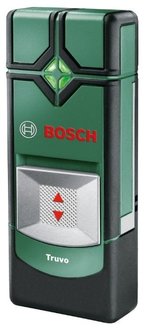 9.6 / 10
Rating
Reviews
High-quality and fairly affordable (for this brand) detector. Wiring in the plaster catches perfectly. |
|
Externally and according to the characteristics of an interesting detector pipes and wiring, but controversial practice. Of course, the “picture” of ADA Instruments provided a good one — a shockproof case with a digital display, the ability to search not only for wires and metal, but also wood. According to the stated characteristics of the depth of search, the device is identical to “Bosch”, and the tree “sees” at a depth of up to 20 mm. However, if you take it in your hands and start using it, the feeling deteriorates somewhat. And since the installation of the battery - here used the "Krona", with its scanty capacity. Even a good quality battery will last no more than six hours of work, and then under ideal conditions. Switching the detector to the search mode of the wiring, you can find that its accuracy when searching for wiring under voltage is not the best, it happens that in the “metal” mode the wire is localized even more accurately. The advantages of digital depth indication are clearly leveled. Well, and when you want to mark the place of the “surprise” found, you will understand that the manufacturer has not provided any corners or holes for marking. This is a paradox - although in comparison with ADA, Bosch looks like a simple “gauge”, in practice it turns out to be more convenient and more accurate. Therefore, the order of places in the ranking of the best wiring detectors is built as expected. Main advantages:
Minuses:
|
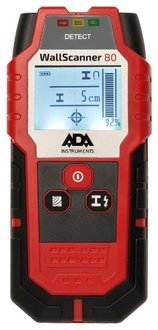 9.5 / 10
Rating
|
|
2 761
Bah, it's ADA Instruments twin brother, only blue! In a good, naturally, sense. However, here in the characteristics indicated the ability to search for "ink" in the walls as much at a depth of 100 mm. In addition, it is even cheaper, even a little. But, nevertheless, we will set the rating points exactly as you see it. First of all, we speak first of all about the wiring detectors - and with the search for wires at the Bison the same problems as the previous participant. At the same time, although the detection of non-ferrous metals is better on paper (80 mm versus 60), in practice there is no difference. But, if ADA Instruments is at least a really existing and well-known Hong Kong company whose products are sold all over the world, then Zubr is, as usual, supposedly a Russian manufacturer, whose real origin of goods is more accurate than “somewhere in China ", Do not label. Main advantages:
Minuses:
|
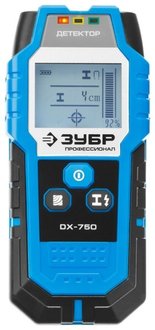 9.3 / 10
Rating
Reviews
Powered wiring detector for its price is acceptable. Armature, however, sees better than wires, alas. |
The best mid-range wiring detectors
|
A good universal detector that can “see” wiring under voltage at a depth of 50 mm, steel - up to 120. When searching for de-energized wiring, you will have to rely on a “color” mode with a maximum detection depth of 80 mm. Tree search is possible at a depth of up to 38 mm. The display of the device is double - a liquid crystal display and a “eye” rim that changes color, through which you can immediately mark the place found with a pencil or thin marker. However, it is worth noting the feature of the device, which is not always paid attention to (it’s customary to read the instructions when something breaks, as you know): the device’s auto-calibration time after switching on is at least 8 seconds, and all this time it should be guaranteed it is distant from metal, otherwise it will begin to show if not “the weather on Mars”, then “the average temperature in the hospital” - exactly. Also, do not forget about manual calibration, fulfilling the conditions specified in the same instructions. A curious feature of the GMS 120 is a separate “drywall” mode, in which, by the way, the device can also find plastic pipes with water. The rest of the set of modes is traditional - "metal", "non-metal", "wire under current". Alas, despite belonging to the "blue" professional series, the device is not attributed to the truly professional - this is not the case when the "Bosch" everything turned out as planned. The device is still not enough "long-range", and elementary capricious to working conditions. Main advantages:
Minuses:
|
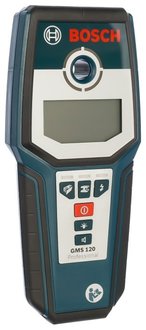 9.4 / 10
Rating
Reviews
I expected more from “Bosch” ... Although, of course, this is not a tracker, but a metal detector, though. |
|
According to the stated specifications, this wiring detector is a direct competitor of Bosch, and at the price of an ADA is even more interesting. True, the manufacturer for some reason closes the hole inside the ring indicator with a cork, which is not always pulled out, even if you work hard - and how would you like to mark the point found? On the narrow "marking lines" on the front panel, as indicated by the instructions? It is frankly inconvenient, and it was not clear what made it impossible for the manufacturer to make the same hole as for Bosch. In general, the device is interesting if you know how to use it (about the nuances of detectors of this type - below). True, using the same “Krona”, it is not very economical, you should always have a spare battery on hand. Main advantages:
Minuses:
|
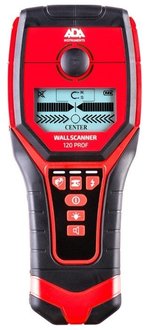 9.3 / 10
Rating
Reviews
It works, in principle, at the level of the 120th Bosch, plus or minus, but cheaper. |
|
5 290
A curious case: for the price, the device of the “green” amateur series costs as much as the “blue” detector. In this case, the characteristics of his stated worse - search wiring at a depth of 50 mm, metal - up to 100 mm. Here we pay mainly for the color screen, issuing as much "live" animated help: the device for those who do not read the instructions on paper in principle. The rest of the detector as a detector, nothing unusual. But he sits comfortably in his hand, with the marking of points, like in ADA, there are no stupid problems (the hole is open), so he has the right to buy. Main advantages:
Minuses:
|
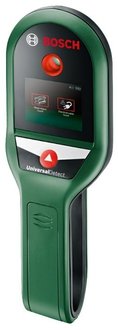 9.1 / 10
Rating
Reviews
Well, the detector is at least convenient; if you can use it, the risk of overshooting is normal for this class. |
|
3 645
Another case where the detector wiring characteristics is not very far away from the good "state employees", but at a price already overtakes them. In principle, it works with wiring and with metal Elitech confidently enough. But the display from him is terrible - it looks like it was taken from radio designers from Aliexpress such as “the Arduino color screen is hot free delivery”, small and illegible (but color, yes). It is small in size, dull, and the viewing angles are not the best. To be honest, the usual black and white screen here would be both more convenient and more appropriate. Main advantages:
Minuses:
|
 9.0 / 10
Rating
|
Top Professional Wiring Detectors
|
But this is already a serious "universal" of the professional class, albeit with an appropriate price. He recognizes metal at a depth of up to 150 mm, wiring under voltage - up to 60. He and plastic pipes with water “see”. The power source is again batteries (although in Bosch levels, for example, they have already begun to replace standard lithium-ion batteries), but at least not the damned “Kron”, but 4 AA batteries that can be replaced with batteries of the same size. The display at the detector is informative, but Russification is killing - it issues all messages in transliteration, like “Dvigat” or “Kabel pod napryaz”. For an expensive device, it looks strange - although, perhaps, razrabotchiki simply re-read Burgess and started a gadget on a nassat? But the signal viewing mode (the one called Prosmotr signala ... no, we’d better in English - Signal View) is often able to show even two adjacent valves separately, rather than as a single object: the accuracy is excellent. Additionally, a useful mode of measuring raw concrete separately from dry is introduced, which is so lacking in cheaper instruments. Main advantages:
Minuses:
|
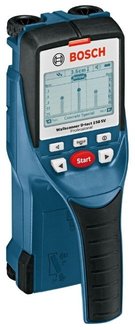 9.8 / 10
Rating
Reviews
The only device of this class that (of those that I experienced) can really be called professional. |
|
Externally, and in terms of performance, the D-tect 150 is no different from the version with the SV prefix, but it costs less. The difference between them is that this model does not have the Signal View mode, that is, it is somewhat rougher, and it can be recognized as single in the vicinity of inclusions in the wall. If you do not need maximum localization accuracy, but it is enough to indicate the area where it is better not to drill the wall, it is not necessary to overpay several thousand for the option with the SV mode - otherwise the detectors are identical. Main advantages:
Minuses:
|
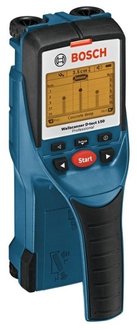 9.7 / 10
Rating
|
Top Road Searchers
|
13 000
A very interesting device that is specifically designed to search for wiring, including deep, and not necessarily a household network under standard voltage. However, more precisely, it is not one device, but two: the detector itself and the transmitter. The principle of detecting wiring is simple: the transmitter creates a high-frequency current in the wire, which is easier to catch even at a decent distance than the standard several tens of hertz. At the same time, a transmitter connected to an accessible end of the wire (for example, to a power outlet whose power supply we are looking for) shows the voltage across it. The signal generated by the transmitter is encoded - thanks to this, you can use several transmitters at the same time, placing a different code on them so that they do not interfere with each other, and the receiver can immediately show which particular line has been found. A serious advantage of detectors with its own signal generator is the ability not only to find the wire as such, but also to detect the place of a hidden break. So the functionality of the CEM is really more than worthy. As to the minuses, we note that both the transmitter and the receiver are powered by “Kron”. But, if you can use a bipolar connection when working with household wiring (the transmitter switches to mains supply), the receiver does not have a “spare” power supply. So the supply of "Kron" in the case is worth making, even with modern 9-volt batteries, the capacity is not impressive. Well, nevertheless, we advise you to read the instructions before use, although this is for a Russian person and not typical - this will avoid misunderstandings and the banal misuse of the detector. Main advantages:
Minuses:
|
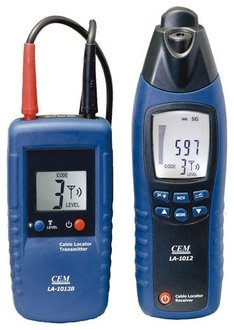 9.6 / 10
Rating
Reviews
An excellent detector, especially when looking for a cliff - the usual incapable of it. |
How to choose a good wiring detector?
Any detector of hidden wiring in the search mode is wiring - this is essentially a radio receiver (so we mentioned the Soviet method of searching for wires from the outlet for nothing), searching for the background that is inevitably emitted by the wires under alternating current. But the problem is that the radiation at “industrial” frequencies (in our country - 50 Hz) is very small, so the receiver has to be made very sensitive. And hence the "capriciousness" of wiring detectors, which is often complained about, tritely not knowing how to use them.
For example, if your brand new detector shows the wiring directly below you, even hanging in the air in the middle of the room - do not rush to run back to the store and write angry reviews on the Internet, just turn off the Wi-Fi router and put the phone out of your pocket. Do not forget to apply your free hand to the wall along which you drive the detector - this also directly affects the interference. It is enough to touch the end of the “jack” of the switched on amplifier once with a hand to make sure with your own ears that the human body itself can give guidance to sensitive equipment. In addition, three-phase live cables can often be “seen” only in the metal search mode, since a phase shift of 120 degrees in the adjacent cables prevents the detector from recognizing the signal normally.
In this regard, the searchers look preferable - they, on the contrary, interfere with the wiring themselves, using it as an antenna, and the receiver's sensor is looking for a very specific signal. Due to this, the depth and accuracy of detection increases significantly, it becomes possible to work with direct current wiring (which does not emit by itself), de-energized and dangling.But even here, there are some minuses - you need physical access to the necessary line to connect the transmitter, so the tracker will not find the same armature. Therefore, in terms of universality, the detectors definitely have their advantages, even though they have to be paid both figuratively (low noise immunity) and literally (high-quality detectors are not cheap).
